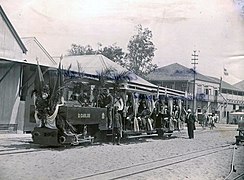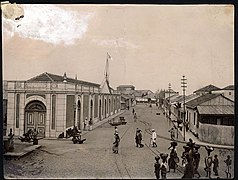Portuguese Mozambique
Portuguese Mozambique (Portuguese: Moçambique) or Portuguese East Africa (África Oriental Portuguesa) were the common terms by which Mozambique was designated during the period in which it was a Portuguese colony. Portuguese Mozambique originally constituted a string of Portuguese possessions along the south-east African coast, and later became a unified colony, which now forms the Republic of Mozambique.
Province of Mozambique
Colony of the Portuguese Empire (1505–1951)
Overseas province of Portugal (1951–1972)
State of the Portuguese Empire (1972–1975)
Cidade de Pedra (1507–1898)
Lourenço Marques (1898–1975)
Pêro de Anaia (first)
Vítor Manuel Trigueiros Crespo (last)
1505
25 June 1975
Mozambican real (1852–1914)
Mozambican escudo (1914–75)
Portuguese trading settlements—and later, colonies—were formed along the coast and into the Zambezi basin from 1498 when Vasco da Gama first reached the Mozambican coast. Lourenço Marques explored the area that is now Maputo Bay in 1544. The Portuguese increased efforts for occupying the interior of the colony after the Scramble for Africa, and secured political control over most of its territory in 1918, facing the resistance of Africans during the process.
Some territories in Mozambique were handed over in the late 19th century for rule by chartered companies like the Mozambique Company (Companhia de Moçambique), which had the concession of the lands corresponding to the present-day provinces of Manica and Sofala, and the Niassa Company (Companhia do Niassa), which had controlled the lands of the modern provinces of Cabo Delgado and Niassa. The Mozambique Company relinquished its territories back to Portuguese control in 1942, unifying Mozambique under control of the Portuguese government.
The region as a whole was long officially termed Portuguese East Africa, and was subdivided into a series of colonies extending from Lourenço Marques in the south to Niassa in the north. Cabo Delgado was initially merely a strip of territory along the Rovuma River, including Cape Delgado itself, which Portugal acquired out of German East Africa in 1919, but it was enlarged southward to the Lurio River to form what is now Cabo Delgado Province. In the Zambezi basin were the colonies of Quelimane (now Zambezia Province) and Tete (in the panhandle between Northern Rhodesia, now Zambia, and Southern Rhodesia, now Zimbabwe), which were for a time merged as Zambezia. The colony of Moçambique (now Nampula Province) had the Island of Mozambique as its capital. The island was also the seat of the Governor-General of Portuguese East Africa until the late 1890s, when that official was officially moved to the city of Lourenço Marques. Also in the south was the colony of Inhambane, which lay north-east of Lourenço Marques. Once these colonies were merged, the region as a whole became known as Moçambique.
According to the official policy of the Salazar regime, inspired on the concept of Lusotropicalismo, Mozambique was claimed as an integral part of the "pluricontinental and multiracial nation" of Portugal, as was done in all of its colonies to Europeanise the local population and assimilate them into Portuguese culture. This policy was largely unsuccessful, however, and African opposition to colonisation led to a ten-year independence war that culminated in the Carnation Revolution at Lisbon in April 1974 and the independence from Portugal in June 1975.
During its history as a Portuguese colony, the present-day territory of Mozambique had the following formal designations:
Portuguese East Africa was located in south-eastern Africa. It was a long coastal strip with Portuguese strongholds, from current day Tanzania and Kenya, to the south of current-day Mozambique.
In 1900, the part of modern Mozambique northwest of the Zambezi and Shire Rivers was called Moçambique; the rest of it was Lourenço Marques. Various districts existed, and even issued stamps, during the first part of the century, including Inhambane, Lourenço Marques, Mozambique Colony, Mozambique Company, Nyassa Company, Quelimane, Tete, and Zambésia. The Nyassa Company territory is now Cabo Delgado and Niassa.
In the early- and mid-20th century, a number of changes occurred. Firstly, on 28 June 1919, the Treaty of Versailles transferred the Kionga Triangle, a 1,000 km2 (390 sq mi) territory south of the Rovuma River from German East Africa to Mozambique.
During World War II, the Charter of the Mozambique Company expired, on 19 July 1942; its territory, known as Manica and Sofala, became a district of Mozambique. Mozambique was constituted as four districts on 1 January 1943 — Manica and Sofala, Niassa, Sul do Save (South of the Save River), and Zambézia.
On 20 October 1954, administrative reorganization caused Cabo Delgado and Mozambique districts to be split from Niassa. At the same time, the Sul do Save district was divided into Gaza, Inhambane and Lourenço Marques, while the Tete district was split from Manica and Sofala.
By the early 1970s, Mozambique was bordering the Mozambique Channel, bordering the countries of Malawi, Rhodesia, South Africa, Swaziland, Tanzania, and Zambia. Covering a total area of 801,590 km2 (309,500 square miles, slightly less than twice the size of California). With a tropical to subtropical climate, the Zambezi flows through the north-central and most fertile part of the country. Its coastline had 2,470 km (1,530 miles), with 4,571 km (2,840 miles) of land boundaries, its highest point at Monte Binga (2,436 metres, 7,992 ft). The Gorongosa National Park, founded in 1920, was the main natural park in the territory.
The districts with their respective capitals were:[8]
Other important urban centres included Sofala, Nacala,[18] António Enes, Island of Mozambique and Vila Junqueiro.[16]









